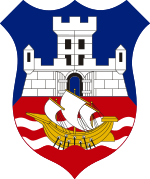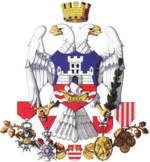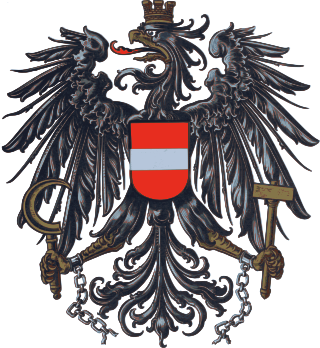
The current coat of arms of the Republic of Austria has been in use in its first forms by the First Republic of Austria since 1919. Between 1934 and the German annexation in 1938, the Federal State used a different coat of arms, which consisted of a double-headed eagle.

The coat of arms of the Republic of Serbia consists of two main heraldic symbols which represent the identity of the Serbian state and Serbian people across the centuries: the Serbian eagle and the Serbian cross. The coat of arms also features the Serbian historical crown; while unusual for republics, it is not unprecedented, as can be seen in coat of arms of numerous European countries with republican form of government. However, Serbia's coat of arms still retains strong monarchist elements absent from the other republics, including the mantle and pavillon found in the greater coat of arms of some modern and many historical monarchies.
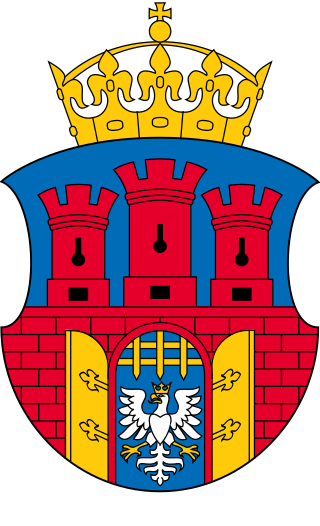
The city of Kraków uses a coat of arms, a seal, official colors, a flag, and a banner as its official symbols. Additionally, a number of semi-official and unofficial symbols of the city are also used.

The coat of arms of Poznań consists of white city walls with three towers. On the left (heraldic) tower stands Saint Peter with a key and on the heraldic right one stands Saint Paul with a sword. In the gate there are two golden crossed keys with a cross above. Over the middle tower, which contains a single window and is topped by a battlement, there is a gothic shield with a white eagle in crown. On the sides of the two saints there are golden crescents and stars. All of those elements are on a blue field. Over the shield there is golden crown. Author of modern version of coat of arms is Jerzy Bąk.

The coat of arms of Russia derives from the earlier coat of arms of the Russian Empire. Though modified more than once since the reign of Ivan III (1462–1505), the current coat of arms is directly derived from its medieval original, with the double-headed eagle having Byzantine and earlier antecedents. The general tincture corresponds to the fifteenth-century standard.

A mural crown is a crown or headpiece representing city walls, towers, or fortresses. In classical antiquity, it was an emblem of tutelary deities who watched over a city, and among the Romans a military decoration. Later the mural crown developed into a symbol of European heraldry, mostly for cities and towns, and in the 19th and 20th centuries was used in some republican heraldry.

The double-headed eagle is an iconographic symbol originating in the Bronze Age. A heraldic charge, it is used with the concept of an empire. Most modern uses of the emblem are directly or indirectly associated with its use by the late Byzantine Empire, originally a dynastic emblem of the Palaiologoi. It was adopted during the Late Medieval to Early Modern period in the Holy Roman Empire, Albania and in Orthodox principalities, representing an augmentation of the (single-headed) eagle or Aquila associated with the Roman Empire. In a few places, among them the Holy Roman Empire and Russia, the motif was further augmented to create the less prominent triple-headed eagle.

The coat of arms of Portugal is the main heraldic insignia of Portugal. The present model was officially adopted on 30 June 1911, along with the present model of the Flag of Portugal. It is based on the coat of arms used by the Kingdom of Portugal since the Middle Ages. The coat of arms of Portugal is popularly referred as the Quinas.
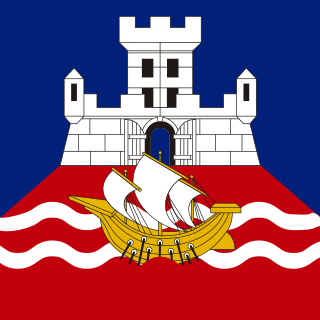
The Flag of Belgrade is composed of three Serbian national colours: red, blue and white. The blue symbolises hope and faith in better future. The red of the ground is a symbol of the suffering of Serbian people in a struggle for freedom. Two horizontal white lines represent the Sava and Danube rivers, which are symbols of the strength of Belgrade. They are white according to heraldry rules. "Beograd" is Serbian name for "White City," so there are white walls and towers. The walls represent a merchant city; the towers and open gate represent an open market. The ship, a Roman trireme, is a symbol of the antiquity of the city.

Đorđe Andrejević-Kun was a Serbian painter and graphic artist, a participant in the Spanish Civil War and the National Liberation War in Yugoslavia and a member of the Serbian Academy of Sciences and Arts. He is known for his paintings, graphic designs and woodcuts. He designed the coat of arms of Belgrade, the emblem of the Socialist Federal Republic of Yugoslavia and several Yugoslav orders and medals.

The coat of arms of Bucharest is the heraldic symbol of the capital city of Romania. The present-day coat of arms was adopted by Domnitor Alexandru Ioan Cuza, and changed under the Communist regime. In 1994, it was renewed again with minor alterations.

The coat of arms and the flag that serve as the symbols of the Radomsko County, Łódź Voivodeship in Poland. They were established in 2000.

The coat of arms of Amsterdam is the official coat of arms symbol of the city of Amsterdam. It consists of a red shield and a black pale with three silver Saint Andrew's Crosses, the Imperial Crown of Austria, two golden lions, and the motto of Amsterdam. Several heraldic elements have their basis in the history of Amsterdam. The crosses and the crown can be found as decorations on different locations in the city.

The Serbian eagle is a double-headed heraldic eagle, also known as the White eagle, a common symbol in the history of Serbian heraldry and vexillology. The double-headed eagle and the Serbian cross are the main heraldic symbols which represent the national identity of the Serbian people across the centuries, originating from the medieval Nemanjić dynasty. The eagle, defaced with the cross, has been used in the coat of arms of the Kingdom of Serbia from 1882 to 1918 and in contemporary coat of arms of the Republic of Serbia since 2004.

Serbian heraldry involves the study and use of coats of arms and other heraldic insignia in the country of Serbia or by Serbs. The Serbian government is the armiger in Serbia, exercising that right under the advice of the Serbian Heraldry Society, a learned society devoted to the study and creation of heraldry, specifically Serbian heraldry.
A national coat of arms is a symbol which denotes an independent state in the form of a heraldic achievement. While a national flag is usually used by the population at large and is flown outside and on ships, a national coat of arms is normally considered a symbol of the government or the head of state personally and tends to be used in print, on armorial ware, and as a wall decoration in official buildings. The royal arms of a monarchy, which may be identical to the national arms, are sometimes described as arms of dominion or arms of sovereignty.

The coat of arms of Groningen is an official symbol of the province. It was designed when the region was united in 1595 and formally approved in 1947 by Queen Wilhelmina. The coat of arms consists of two lions supporting a crowned shield which is decorated with the shields of the city of Groningen and of the Ommelanden.

The coat of arms that serves as the official symbol of the Masovian Voivodeship, Poland, consists of a red escutcheon, that features a white (silver) eagle, with raised wings, and its head turned left. Its current version had been designed by Andrzej Heidrich, and adopted in 2006.

Coat of arms of Riga is one of the official symbols of Riga, along with the flag of Riga.

The flag of Poznań is a rectangular piece of white material with the coat of arms of the city placed in the middle. It was adopted in 1997.
